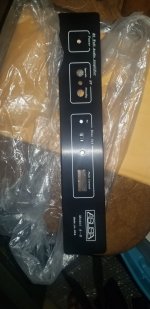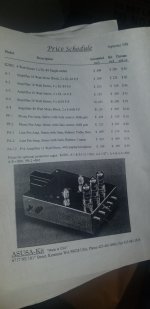About a month ago I made a deal to buy a pair of partially assembled 100 watt mono amps from ASUSA. The amps aren’t yet in my possession but are paid for and I should have them this Sunday or Monday - I just need to go pick ‘em up and will post more pictures of these when I have ‘em.
Apparently these use a couple of 6146 output tubes, driven to 100 watts. These amps may or not have been one of their kits but possibly some stock being assembled shortly before their closure (?); I haven’t been able to find any info on these in this 100 watt version and don’t have a schematic.
I’ll be needing help building these up.. I’d like to stay with a 6146 build to try it out. I know that in the ‘50s, Altec made some theater amps using the 6146 tubes so maybe that circuit could be an option.
Pictures I have as of today; more to come when they’re here:




Apparently these use a couple of 6146 output tubes, driven to 100 watts. These amps may or not have been one of their kits but possibly some stock being assembled shortly before their closure (?); I haven’t been able to find any info on these in this 100 watt version and don’t have a schematic.
I’ll be needing help building these up.. I’d like to stay with a 6146 build to try it out. I know that in the ‘50s, Altec made some theater amps using the 6146 tubes so maybe that circuit could be an option.
Pictures I have as of today; more to come when they’re here:
6146 was the darling of dental surgery, it would zap diseased gums. Now in high favor among classic ham radio operators. It is also known from the first series of Ampeg SVT 300 Watt (3 pair) guitar/bass amplifier. If 6146 become scarce, 6550 and KT88 will work and without the exposed plate connection.
Read up on the different 6146 tubes. IIRC, the 6146 and 6146A are identical except for a minor change in the filaments and they are interchangeable. The 6146B is different enough so that you shouldn't mix Bs with As or regular 6146. I don't think they're a bad audio tube as long as the screen voltage is kept low, which I would have to assume was done with these. Best not to use them with UL taps.
There was also a Maestro 6146 amp from the early fifties (1952) which was featured in several articles. You should be able to find that with Google. IIRC it had 750 volts on the plates and a regulated 200 on the screens. It was a fairly 'standard' Williamson design.
There was also a Triad HF-40, again a fairly 'standard' Williamson. That should come up with Google, too.
Nice find, btw.
There was also a Triad HF-40, again a fairly 'standard' Williamson. That should come up with Google, too.
Nice find, btw.
MisterDKAddicted Member
Messages:8,806Location:California, USANew
Question about the caps next to the transformers - I bought these amps with the seller wanting to keep those. They’re 220μF / 500v. I’m assuming that they’re for the power supply (?). The guy I got the amps from says that they’re likely to be way too much filtering and the amp should sound more open with caps of a lower μF value. I need to let him know soon whether or not I’ll keep those or pull ‘em and put a lower value in. Any thoughts on those?
Ask him if he's also got a bridge over the Grand Canyon for sale? If those caps are in there, and that's what he sold you, keep 'em.
Well - I knew he wanted to keep those when he sold me the amp. Caps are genuine Elna Cerafine and somewhat costly, even used.
I picked these up last night - some pictures.
Tubes may not be correct but they’re all NOS, put in by the guy I bought the amps from. 6146A’s, JAN 6SN7WGTB’s and OD3’s. He promised he’d give me the same for the other amp..






Tubes may not be correct but they’re all NOS, put in by the guy I bought the amps from. 6146A’s, JAN 6SN7WGTB’s and OD3’s. He promised he’d give me the same for the other amp..
The 2 x 6SN7s would fit a Williamson design. For using a tube rectifier (I'm assuming that given the tube count) there are a lot of diodes in there.
Please be aware that the 6146 was an RF tube, designed for transmitter output operation. It is prone to oscillation if the layout is not carefully performed.
I have a kit or part of a kit not fully sure and only a little bit of paper work6146 was the darling of dental surgery, it would zap diseased gums. Now in high favor among classic ham radio operators. It is also known from the first series of Ampeg SVT 300 Watt (3 pair) guitar/bass amplifier. If 6146 become scarce, 6550 and KT88 will work and without the exposed plate connection.
Attachments
Would you share a copy of those I have a kit or part of one for the asusa amp a-8 I have a few pages of blueprints but dont think I have them all.After closer inspection I have the blueprints for the 80 w amplifier.
What I really need is how to install all these resistors and caps, some pictures would be wonderful
6146 is unique in its ability to deliver power in pentode Class AB1 - 120 W ICAS for a pair, compared to 807's 72 W. And this is with very low screen voltage of 180 V. KT88 and 6550 work optimally with much higher screen voltages, and they deliver less power, even with their much higher max plate dissipation. 6146 circuits will need to be re-worked for these tubes.
Top plate connection is an advantage because it allows higher plate voltages.
6146 transconductance is about the same as 6L6 types, so they don't need more stringent anti-oscillation measures.
Max screen voltage for 6146 in triode or UL is 400 V, so it can be used in UL up to this voltage.
6146 is less linear than 807, Approximately 2x distortion under comparable conditions.
Top plate connection is an advantage because it allows higher plate voltages.
6146 transconductance is about the same as 6L6 types, so they don't need more stringent anti-oscillation measures.
Max screen voltage for 6146 in triode or UL is 400 V, so it can be used in UL up to this voltage.
6146 is less linear than 807, Approximately 2x distortion under comparable conditions.
- Home
- Amplifiers
- Tubes / Valves
- Requesting help building ASUSA 100 watt, 6146 tube mono amps

